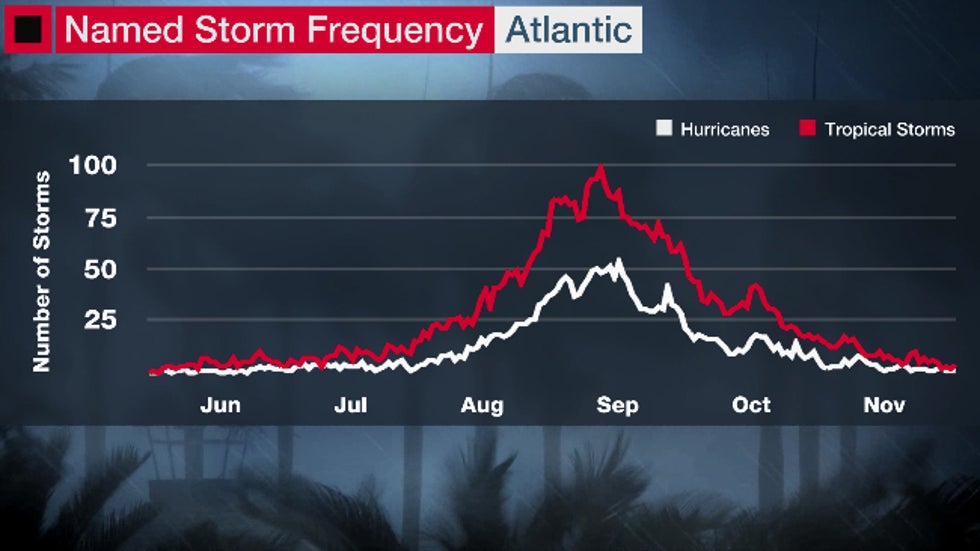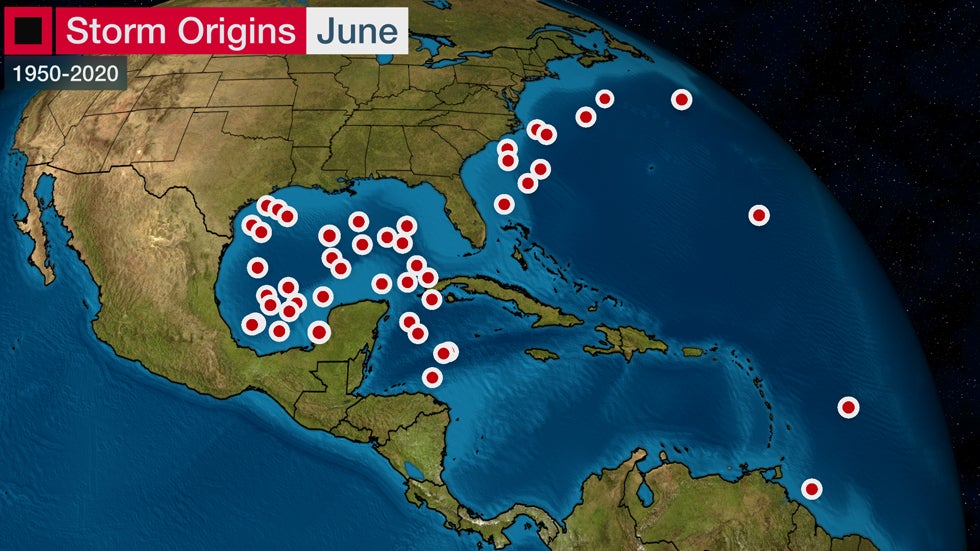Chris Dolce
Hurricane season officially begins Tuesday, June 1, and while it's expected to be another active year, the early part of the season has historically been slow.
The National Hurricane Center selected the June 1 to Nov. 30 period for the Atlantic hurricane season because it encompasses more than 97% of tropical cyclones. But storms can occasionally form before or after those dates, as we saw this May with the brief development of Tropical Storm Ana east of Bermuda.
Early in the season, we typically do not look at the main development region of the central and eastern Atlantic for tropical storms or hurricanes. We look closer to home.
 This animation shows the typical formation areas and tracks for named storms in June and July.
This animation shows the typical formation areas and tracks for named storms in June and July.The southeastern U.S. coast, the Gulf of Mexico and the western Caribbean Sea are breeding grounds for tropical cyclones in June. July is when we start to look a bit farther east because the region of the Atlantic near the Lesser Antilles can also become riper for development.
Since storms that form early in the year typically start out closer to land, that can increase the chance of impacts along the Gulf and Southeast coasts of the U.S., as well as parts of the Caribbean.
Early-Season Activity Is Typically Slow
Just 13% of the tropical storms from 1851 to 2018 in the Atlantic have occurred in June and July combined. For comparison, August, September and October have accounted for 24%, 36% and 21% of all tropical storms on record, respectively.
 The typical frequency of named storms (in red) and hurricanes (in white) by month in the Atlantic Basin.
The typical frequency of named storms (in red) and hurricanes (in white) by month in the Atlantic Basin.On average, there's one June named storm in the Atlantic, Caribbean or Gulf of Mexico every one to two years. July has a slightly higher rate of occurrence, but it has still averaged less than one named storm per year since 1851.
Last year's hyperactive hurricane season was an exception to the general slow start rule of thumb.
First, Arthur and Bertha developed in late May.
There were two named storms in June, including Cristobal and Dolly. Cristobal struck southeastern Louisiana as a tropical storm.
That was followed by a July that had five named storms form in the month for just the second time on record. Two of those storms became hurricanes: Hanna and Isaias.
By the end of July, the Atlantic already had a record-breaking nine named storms develop.
It's Not Too Early for Major Impacts
Audrey is the strongest U.S. landfalling hurricane in June. It roared ashore in Cameron Parish, Louisiana, as a Category 4 on June 27, 1957.
But it doesn't take an early-season hurricane in June to cause significant impacts.
Take Tropical Storm Allison in June 2001. Allison made landfall as a low-end 50-mph tropical storm near Freeport, Texas, and quickly weakened to a tropical depression. Its remnants meandered and lingered for days, allowing an associated slow-moving rainband to flare up and unleash epic amounts of rainfall in the Houston metro area, resulting in severe flooding.
In June 1972, Hurricane Agnes made landfall in Florida, but its legacy is more strongly linked to its second wind as a tropical storm, when it curled northeastward toward New York City and stalled over the Northeast, producing flooding rainfall in the interior of the region.
 Each dot shows where a named storm has formed in June since 1950.
Each dot shows where a named storm has formed in June since 1950.It's been 35 years since the U.S. last had a hurricane make landfall in June. That was Bonnie near High Island, Texas, in late June 1986.
Hanna (2020) and Barry (2019) are the most recent hurricanes to make a U.S. landfall in July.
Arthur (2014), Dolly (2008), Cindy (2005), Dennis (2005) and Claudette (2003) are the only other five hurricanes to make a U.S. landfall during July in this century.
The Weather Company’s primary journalistic mission is to report on breaking weather news, the environment and the importance of science to our lives. This story does not necessarily represent the position of our parent company, IBM.
The Weather Company’s primary journalistic mission is to report on breaking weather news, the environment and the importance of science to our lives. This story does not necessarily represent the position of our parent company, IBM.

No comments:
Post a Comment